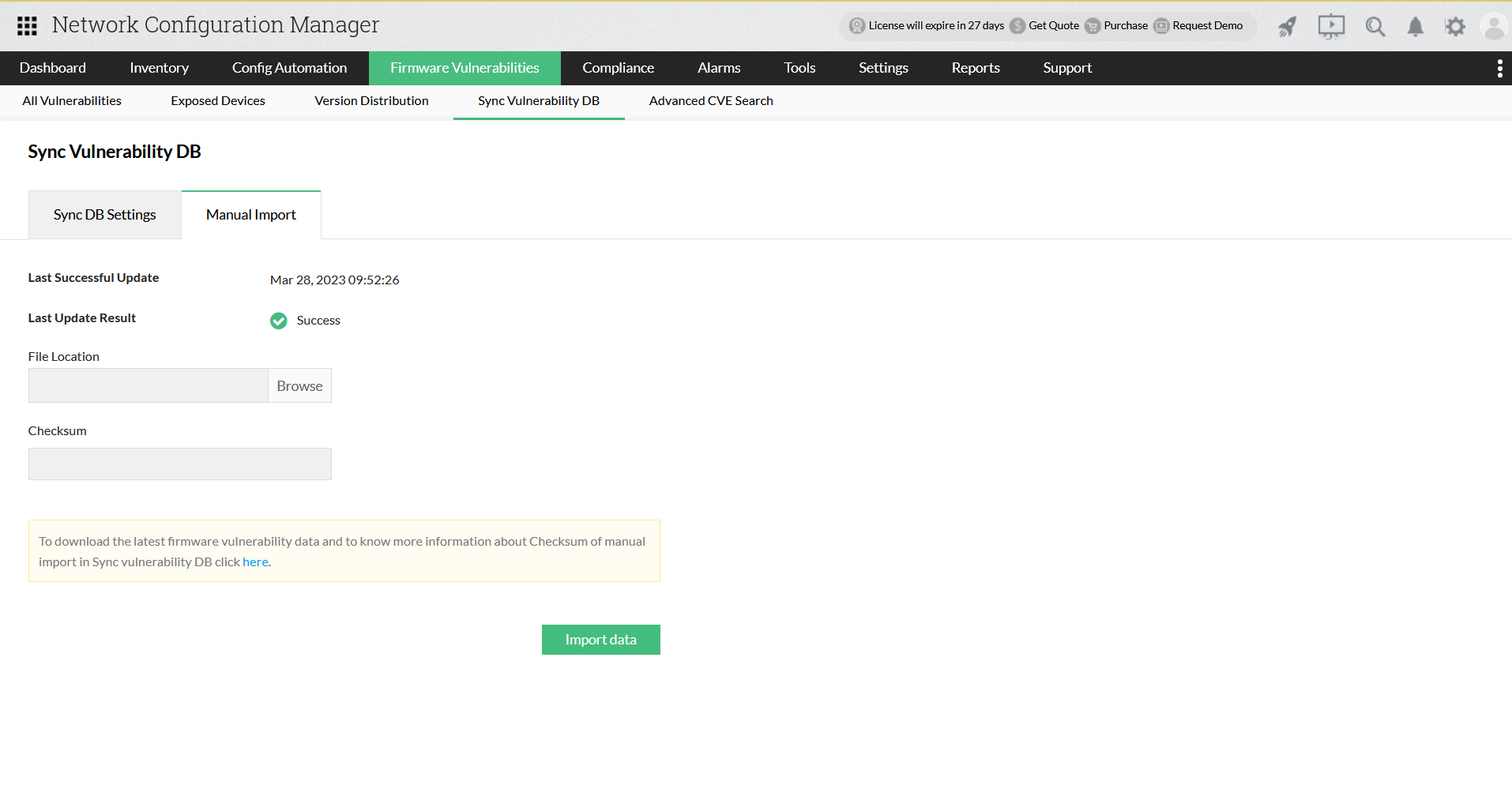Note: For firmware vulnerability sync, we get data from Network Configuration Manager's ManageEngine database: https://ncm.nimbuspop.com. Customers must allow access to the domains "https://ncm.nimbuspop.com" and "https://www.manageengine.com" from NCM installed server in order to retrieve the data.
Firmware vulnerabilities can put your business and your customers’ sensitive data at risk, leading to easy entry to hackers, diminished sales, reputation loss and penalties. In order to avoid these mishaps, it is important to identify firmware vulnerabilities and take corrective measures regularly.
With Network Configuration Manager, you can manage firmware vulnerability by identifying potential vulnerabilities in your network devices and upgrade device firmware remotely. Network Configuration Manager works in accordance with NIST (National Institute of Standards and Technology) by fetching firmware vulnerability data and correlating it with the network devices which are currently managed in your infrastructure. At present, Network Configuration Manager helps to manage firmware vulnerability for vendors in the table below.
| Vendor | Version support |
|---|---|
| Citrix |
Supports from 126130 |
| Mikrotik | |
| Checkpoint | |
| F5 | |
| Bluecoat | |
| InfoBlox | |
| RiverBed | |
| Huawei | |
| Netgear | |
| Hpe | |
| Netscreen | |
| Cisco |
Supports from 124098 |
| Juniper | |
| Palo Alto | |
| HP | |
| Aruba | |
| Arista | |
| Fortinet | |
| Dell |
In Firmware Vulnerabilities page, Network Configuration Manager lists out all the vulnerabilities in your network and the number of devices affected by those vulnerabilities. You can view the details of that vulnerability associated to a particular CVE ID and immediately carry out the remediation methods.
Follow the instructions in order to see the severity of vulnerabilities and the devices which are vulnerable:
By clicking on the CVE ID, you can you can get in-depth information about the firmware vulnerability. Follow the instructions to see the CVE details in Network Configuration Manager:
Network Configuration Manager categorizes the severity of vulnerabilities based on the "Base score" which is calculated based on a few metrics like Exploitability Metrics(Attack, Complexity, Authentication) and Impact Metrics(Confidentiality, Integrity, Availability). Here is the split up of how the severity is categorized:
Vulnerability data from NIST can be synced with the DB of Network Configuration Manager. Users can set a time of schedule in order to sync data on a daily basis. When a schedule time is set, the synchronization of vulnerability data happens automatically at the exact time of schedule. Network Configuration Manager also allows you to edit/change the time of schedule as per your convenience. If no schedule time is set, sync happens every night at 2 a.m by default.
The data is received from Network Configuration Manager's ManageEngine database: https://ncm.nimbuspop.com, which needs to be allowed by users to get data of vulnerabilities.
If you wish to update the Vulnerability data in the NCM UI immediately instead of the scheduled time, you can give the "Update Now" option. When "Update Now" is given, the latest vulnerability data will be updated in the NCM DB.
Follow the instructions in order to run a daily schedule for synchronizing vulnerability data:
If your network is closed, you will not be able to update vulnerability database automatically using firmware vulnerability scanning with data from NIST vulnerability management. In that case, you can go for a manual import of vulnerability data.
Note: Modification of the imported dump by the customer may lead to corruption of vulnerability dump present in Network Configuration Manager.

Network Configuration Manager provides reports on firmware vulnerability to help you gain clarity into the affected devices, its status and the remediation for the vulnerability. You can export the report as a PDF, CSV file or get the report via Email.
With "Advanced CVE search" you can globally search for all the vulnerabilities by searching using the vendor name, CVE ID, device OS number, version or a model. For eg: If you search "Cisco IOS 7000", all the vulnerabilities present in that particular model will be listed. On further clicking it, you will be able to see all the details of the vulnerability corresponding to a particular CVE ID. Follow the instructions to perform advanced CVE search in Network Configuration Manager:
Thus, Network Configuration Manager helps you achieve in-depth firmware vulnerability management of all the vulnerabilities in your network. Click here to know about firmware upgrade and firmware vulnerability widgets. Try out Network Configuration Manager using the 30-day free trial and see how you can manage vulnerabilities in your network!
Thank you for your feedback!